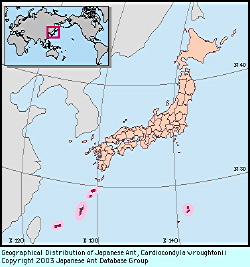
|
species
|
Cardiocondyla wroughtonii
|
 |
Japanese Name
|
Kiiro-hadaka-ari
|
Original Reference
|
|
Forel, A. (1890) Aenictus-Typhlatta dˇcouverte de M. Wroughton. Nouveaux genres de formicides. Annales de la Sociˇtˇ Entomologique de Belgique. Comptes-rendus 34: cii-cxiv.
|
Synonym
|
|
Emeryia wroughtonii Forel (Forel, 1890) ,
Cardiocondyla wroughtonii (Forel) (Forel, 1892) ,
|
Description
|
|
Total length of workers around 1.5 - 2 mm. Bicolored: head, mesosoma, petiole and postpetiole yellow; gaster brown. Head rectangular; occipital border almost straight, but slightly concave in the middle. Eyes relatively large and convex. Scapes not reaching occipital border of head. Mandibles each with 5 teeth; apical tooth largest, the others gradually smaller. Promesonotal area depressed, almost straight in profile; pronotal humeri slightly angulate in dorsal view. Metanotal groove distinct. Dorsal outline of propodeum roundly convex in profile, highest at anterior third; propodeal spines longer than their basal width. Petiole with a relatively long peduncle and high node. Anterior margin of postpetiole concave in dorsal view. Head, mesosoma, petiole and postpetiole shagreened; gaster smooth.
|
Remarks
|
|
The males of this species are dimorphic, complising both alates and ergatoids. Ergatoid males are further divided into 3 types: the first has 13-segmented antennae and falcate mandibles; the second has 12-segmented antennae; and the third has 9-segmented antennae. This species is arboreal and typically nests in hollows in decaying branches. It is thought to have originated in tropical Africa and to have extended its range very widely in the tropics and subtropics through human agency. Chromosome number 2n=52 (Imai & Yamauchi, unpublished).
|
|

Distribution
|
|
Nansei Is, Ogasawara Is, Volcano Is; pantropical, pansubtropical.
|
|
References
|
|
- Onoyama, K. (1976). A preliminary study of the ant fauna of Okinawa-Ken, with taxonomic notes. (Japan: Hymenoptera: Formicidae). . Ecol. Stud. Nat. Cons. Ryukyu Isl., 2, 121-141.
- Kinomura, K. & K. Yamauchi (1987). Fighting and mating behaviors of dimorphic males in the ant Cardiocondyla wroughtoni. . J. Ethol., 5, 75-81.
- Yamauchi, K. & K. Kinomura (1993). Lethal fighting and reproductive strategies of dimorphic males in Cardiocondyla ants (Hymenoptera: Formicidae). . In T. Inoue & Sk. Yamane, eds., ""Evolution of Insect Societies"", 373-402. .
- Wilson, E. O. & R. W. Taylor (1967). The ants of Polynesia (Hymenoptera: Formicidae). . Pacif. Ins. Mon., 14, 1-109.
- Aenictus-Typhlatta dˇcouverte de M. Wroughton. Nouveaux genres de formicides. Annales de la Sociˇtˇ Entomologique de Belgique. Comptes-rendus 34: cii-cxiv.
- Forel, A. (1892). Le male des Cardiocondyla et la faune mediterraneenne. Ann. Soc. Ent. Belg. 36: 458-461.
|
Editor
|
|
Original text by Mamoru Terayama, Katsusuke Yamauchi and Masaaki Morisita. English translation by Mamoru Teraayama, edited by Robert W. Taylor
|
|